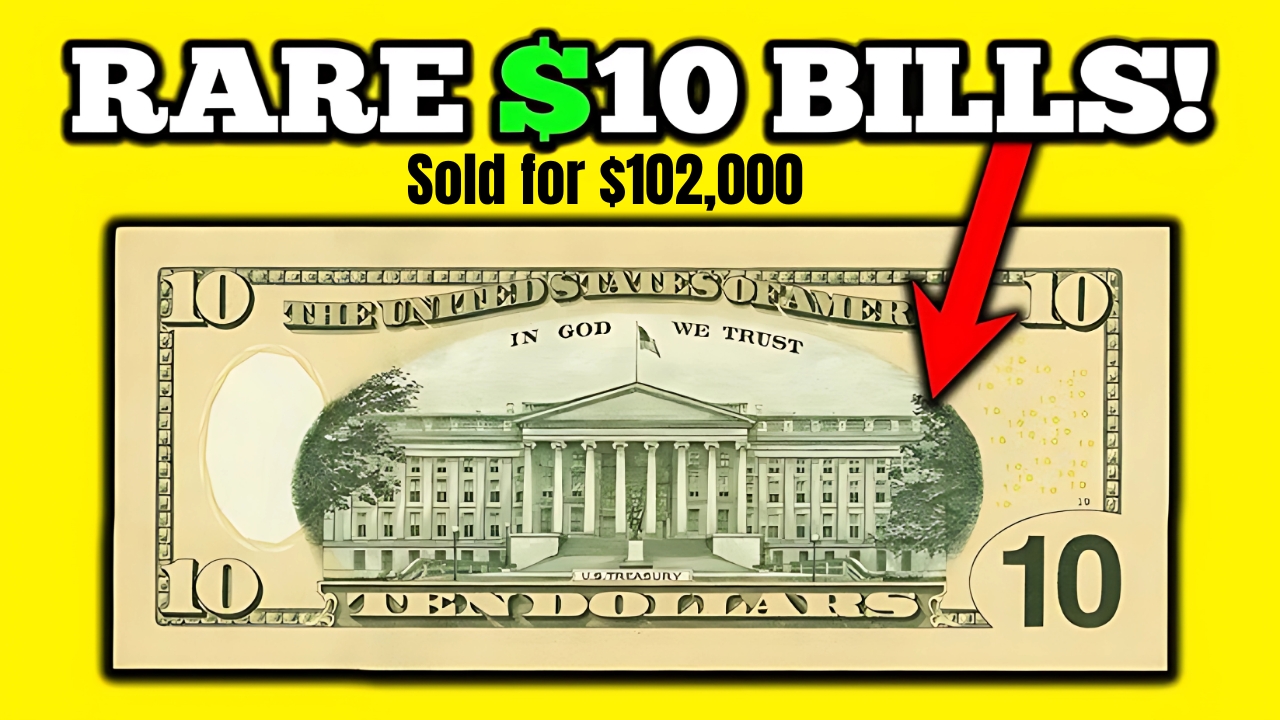The currency collecting world was stunned when a 2021 $10 bill with double printing was discovered in circulation and sold for $102,000. Even more remarkable, another $10 bill with misprint recently sold for $102,000, proving that ordinary-looking bills can hide extraordinary value.
These discoveries have reignited public interest in examining everyday currency for potential errors. The bills appeared normal to casual observers but contained rare printing mistakes that occurred during production at the Bureau of Engraving and Printing, the official U.S. government facility responsible for producing all American paper currency.
What Makes These Bills So Valuable
Currency errors can happen at anytime and on any denomination such as: misprinted dollar bills – $1, $2, $5, $10, $20, $50 and $100 dollar bill error notes. However, modern bills like the 2021 series are exceptionally rare because the Bureau of Engraving and Printing has strict quality controls. Printing errors on newer bills like those from 2021 are extremely rare — and much more valuable if found.
Types of Valuable $10 Bill Errors to Look For
Double Printing Errors
A double printing error occurs when a note is printed twice with the same or overlapping design, resulting in a shadow-like duplication of elements. The 2021 $10 bill that sold for $102,000 featured this exact type of error, where one of the sheets used for the $10 note was accidentally run through the press twice, resulting in two slightly offset sets of printing on the reverse side.
Offset Printing and Misalignment
Print misalignment occurs when one or more image layers on a banknote are printed with incorrect alignment. This can be the result of inaccurate placement of printing plates or a failure in the paper feed mechanism. These errors cause design elements to shift, creating noticeable visual effects that collectors value.
Missing Print Elements
Incomplete printing is an error where one or more layers of printing on a banknote have either not been applied or have been partially applied. This may result in the absence of certain elements, e.g., portrait, serial number or the seal of the Ministry of Finance. Examples include 2013 $10 bill with part of Hamilton’s portrait missing.
Ink Errors and Smudging
Over-inking results in black seal or green seal and/or serial numbers completely missing, while over-inking is the result of an error in the printing process where too much ink is applied to one side of the banknote, creating valuable collecting opportunities.
Error Bill Value Guide and Market Data
| Error Type | Value Range | Recent Sales | Rarity Level |
|---|---|---|---|
| Double Printing | $25,000-$102,000 | $102,000 (2021), $102,000 (Recent) | Extremely Rare |
| Offset Printing | $100-$2,000 | Varies by severity | Uncommon |
| Missing Print | $150-$5,000 | Depends on missing elements | Rare |
| Ink Smears/Over-inking | $100-$500 | Market dependent | Common |
| Cutting Errors | $50-$300 | Based on severity | Moderately Common |
| Serial Number Errors | $100-$1,000 | Collector dependent | Uncommon |
Professional Grading Impact on Value
When it was evaluated by experts at PMG (Paper Money Guaranty), it received a grade of 66 EPQ (Exceptional Paper Quality), which significantly boosted its market value. Professional grading services authenticate errors and assign condition grades that directly impact market value.
How to Identify Potential Error Bills
What to Look For
When examining your $10 bills, inspect it carefully for unusual features like overlapping prints, missing elements, or smudges. Inspect both sides carefully for subtle “ghosting” — signs of overlapping prints that aren’t perfectly registered.
Key Inspection Points
- Check for doubled images or “ghosting” effects
- Examine serial numbers for duplicates or misalignment
- Look for missing design elements
- Notice any ink smears or over-inking
- Verify proper cutting and edges
Professional Authentication Process
If you discover a potential error, don’t spend it, inspect it carefully, do not clean or flatten it, get it graded, and consider auctioning it. Get professional grading: Third-party grading services (like PMG or PCGS Currency) provide authenticity and quality assessment, key to commanding high value.
Government Sources and Official Information
The Bureau of Engraving and Printing is the official source for U.S. currency production information. In 1877, BEP became the sole producer of all United States currency, and they maintain strict quality control standards that make genuine errors exceptionally rare and valuable.
The U.S. Bureau of Engraving and Printing announced plans to undertake new designs every 7-10 years to stay ahead of currency counterfeiters, which affects the rarity and collectibility of different series years.
Market Trends and Collector Interest
Collectors may pay thousands for dollar bills with printing error, with recent sales demonstrating unprecedented interest in modern error notes. Error notes, misprinted bills, FRN errors, Federal Reserve errors notes, mistake dollars, error currency notes, error banknotes, & US paper money errors continue to attract serious collectors willing to pay premium prices.
The discovery of valuable errors in circulation has created a new awareness among the public, leading to increased scrutiny of everyday bills and more discoveries of valuable errors.
FAQs
Q: How common are $10 bill printing errors?
A: Extremely rare, especially on modern bills. The Bureau of Engraving and Printing has strict quality controls, making genuine errors highly valuable.
Q: Should I have my error bill professionally graded?
A: Yes, professional grading from PMG or PCGS Currency is essential for authentication and maximizing value.
Q: Can I still spend an error bill if it’s not valuable?
A: Yes, error bills remain legal tender, but always get professional evaluation first before spending potentially valuable errors
